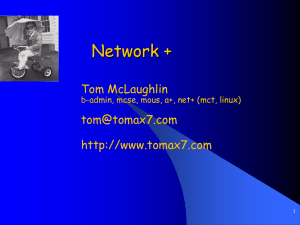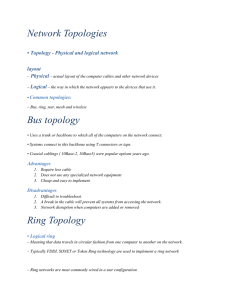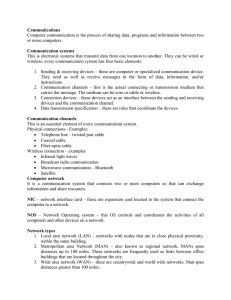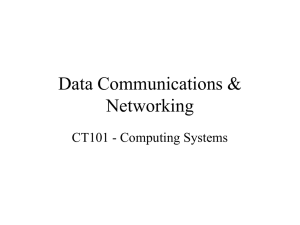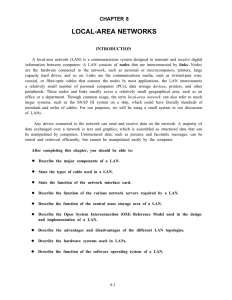Networks Types - Computer Science
advertisement
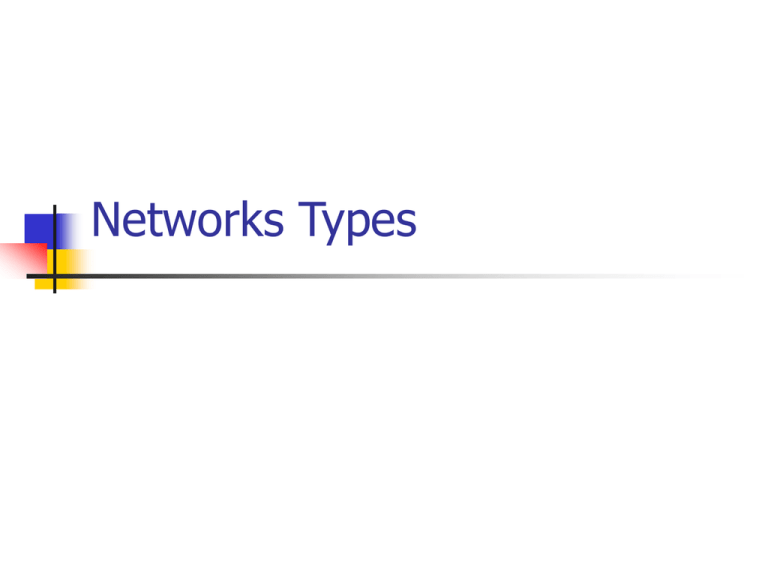
Networks Types Data Transfer During the ’70s: Minicomputers became affordable; Need to communicate information; Data transferred using removable storage device---tapes, floppy. Drawback: Spring 2002 (very) slow Computer Network Applications Point-to-Point (Direct) Connection Dedicated circuit boards connected by cable; To transfer data from A to B: A writes on its circuit board; A’s board transfers data to B’s board; B reads data from its board. A Spring 2002 B Computer Network Applications Point-to-Point Connection (cont.) Pros: Cons: High transfer speed; Secure connection; Difficult to add a new computer to a set of communicating computers. Difficult if communication is between heterogeneous computers; Expensive: circuit boards needed for every pair of communicating computers; How many boards would you need to connect 5 computers via this method? Spring 2002 Computer Network Applications Local Area Network (LAN) A single shared medium, usually a cable, to which computers can attach. PC 1 Printer PC 2 PC n Spring 2002 File Server Computer Network Applications Local Area Networks (cont.) Designed and developed for communications and resource sharing in a local work environment (room, campus, building). Because sharing occurs: Cost decreases Computers have to coordinate the use of the network; Overall, LANs connect more computers than any type of network. Spring 2002 Computer Network Applications Connecting a Computer to a LAN Requires a network interface; A network interface consists of: a circuit board that plugs into the computer A cable that connects the circuit board to the LAN; The network interface isolates a computer from the LAN heterogeneous computers can communicate across the LAN. Spring 2002 Computer Network Applications LAN Topologies Star Topology Bus Ring Spring 2002 Computer Network Applications Star Topology Connections are made from all connected machines to one central place, called a hub. The hub: accepts messages from the sending computer, and sends data to recipient. Spring 2002 Computer Network Applications Star Topology (cont.) Pros: Some degree of fault tolerance: the failure of any link does not affect the other computers; Cons: Spring 2002 Expensive (the hub is a dedicated computer); If the hub fails, no connection is possible. Computer Network Applications Ring Topology Messages in the network are passing from machine to machine. This gives controlled and stable data traffic in the network. No central control or configuration of the traffic. RING Spring 2002 Computer Network Applications Ring Topology (cont.) Sending a message: Spring 2002 There is a special message, called token; Exactly one token exists on the ring at any time which is passed along the ring; To send data, a computer waits for the token to arrive, and then transmits one message; The message is transmitted to the next computer, and then to the next, until it arrives back to the sender. After the message is transmitted, the computer holding the token, passes the token to the next computer in the ring. Computer Network Applications Ring Topology (cont.) Pros: Requires less wire than star; Less expensive; Cons: Spring 2002 If any cable is cut, the entire network is disabled. May incur delays: A computer has to pass the token even if it has more messages to transmit and nobody else does. Computer Network Applications Bus Topology Each unit is connected to a cable. Ex: Ethernet network; original transmission rate: 10 Megabits/s; now: 1000Megabit/s. BUS Spring 2002 Computer Network Applications Bus Topology (cont.) Sending a message: The sender sends a message only when the cable is not in use; The message propagates to both ends of the cable; The receiver process the message (all computers have to check if they are the intended destination) Collisions: Spring 2002 A collision occurs when two computers try to send in the same time garbled transmission; When a collision is detected; each computer have to wait a randomly chosen time before retransmitting. Computer Network Applications Bus Topology (cont.) Pros: Cons: No delays when only one computer wants to transmit; If the bus fails, no transmission possible. Limited number of communicating parties (the bus < 500 m, >3m between two connections) Generally: each topology has adv. and disadv.; Spring 2002 Computer Network Applications Wide Area Networks (WANs) Span a large geographic area, cross public property; Scalable: allow many computers to send data simultaneously; Often based on services provided by 3rd party companies, like telephone networks, for transmission from one node to another; Can be used to connect several LANs together; Spring 2002 Computer Network Applications Packet Switches A WAN is constructed from many switches; A switch moves message fragments called packets from one connection to the other; A switch is a dedicated computer, with two types of connections: Spring 2002 High-speed connections with other switches; they can be: leased phone lines, optical fibers, microwave, satellite. Low-speed connection: used to connect with an individual computer, or a LAN. Computer Network Applications Switched Network Switch High speed connection Switch Spring 2002 Computer Network Applications Switch Transmitting messages across a WAN Store and forward technique: When a packet arrives at a switch: The processor examines the packet and Spring 2002 it is stored into its internal memory; the processor is informed of its arrival; if the destination is idle, then the packet is forwarded to the destination. Otherwise, it places the packet in a queue---it will be sent when the destination is idle. Computer Network Applications WAN (cont.) Pros: Scalable Many messages can be sent simultaneously; A message passes only through switches Fault tolerant: if a switch fails, another route can be found; Cons: Spring 2002 expensive Computer Network Applications



